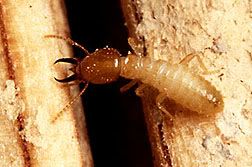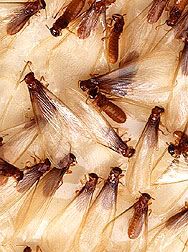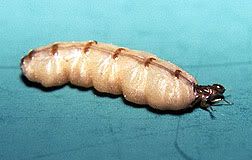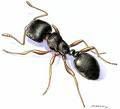Tuesday, June 21, 2005
Drywood termite info plus a new termite treatment
First, if you're getting termites in Florida this time of year, it's likely to be the drywood kind. This is good since they're not as bad as the Eastern subterranean termites. The drywood colonies are much smaller and take years before damage is done.
He also gives some useful details about identifying drywood termites. You don't need to know what a termite looks like to know that they are around. You often can identify them by what they leave behind. It's kind of gross, but be on the lookout for cellulose or wood pellets. Since drywood termites can't directly digest wood, they'll excrete these as their fecal waste. Another waste byproduct of the drywood termites is their wings. The alates shed their wings quickly. These termite wings can be identified by what he calls an "iridescent quality". Another feature of the wing is the 3, 5, or 7 veins on the leading edge. In addition to visual clues, the tunnels that they leave behind can be identified by touch. It'll feel smooth.
The pest control owner described two techniques to get rid of the termites. He considered the easiest and quickest method to be tenting in which a gas is pumped in. The problem is that drywood termites often return since there's no chemicals left behind. I don't know why he considers this the easiest method since it takes a lot of work to get the house ready for the termite fumigation and requires up to four days of vacancy.
The other method he mentioned is something that I've seen before but I don't think is too common. He's in the process of getting certified in this method so perhaps it is new. It involves heating the house to 140°F for 4 hours. This seems like it may be a good home remedy for termites. During a hot summer day, close up the house and blast the heater all day. It would probably be safer to let a professional try this. You'll have to make sure that anything flamable or prone to heat damage is removed from the house. The nice thing about this heat method is that there is no poison, chemicals, or pesticides to worry about after its done.
Technorati Tags: insects, termites
Sunday, June 19, 2005
Getting Rid of Termites Without Chemicals
The herb pesticide is then used as baits. As the queen termite is fed with the pesticide, her egg production goes way down. The only problem with this system is that it can take up to a year to work. But on the other hand, it's a more environmentally friendly termite treatment.
I'll keep a lookout to see when these types of herb pesticides become more recognized in the U.S. These types of inventions often don't prove to be effective. Also, there's the question about whether the treatment works on all types of termites.
Technorati Tags: insects, termites
Termite Identification, Termite Misconceptions, and Termite Treatments
- Dirt trails with widths about a tenth of an inch on the foundation
- Wood damage that follows the grain lines
- Termite wings that are shed by termites around room perimeters and in window wells
The article also mentioned some misconceptions that I haven't seen before. It mentioned that termites don't usually leave piles of sawdust. This is more likely to be ant damage. Also, you'll likely see termite damage first in the basement or near the foundation before seeing damage in the top floors.
The article listed the two most typical termite treatments: bait traps and liquid barriers. The bait traps range in price from $1100 to $1400. The good points about bait traps is that they don't require holes to be drilled in the foundation and there's no poison injected into the soil. However, it takes longer for it to work. In the liquid barrier method, poison is injected into the soil. It gets rid of the termites faster and has a better success ratio. Also it's usually cheaper with prices ranging from $700 to $900.
Finally, the article ended with some common sense termite prevention methods such it fixing leaks and drainage problems since termites like moisture.
Technorati Tags: insects, termites
Saturday, June 11, 2005
Honest termite pest inspectors
He had to get three termite estimates before he found one who provided a reasonable termite treatment plan with a reasonable cost. Unlike the other two, he didn't overstate the problem by calling it the worst termite infestation he's seen in 35 years. And he didn't recommend a procedure like tent fumigation which only kills drywood termites and not subterranean termites. His procedure was to treat only the affected areas. By keeping the treatment targeted and reasonable his cost was only around $700.
This reporter also gave some interesting termite facts such as there are 2500 different kinds of termites in the world with 17 in California. In Southern California, termites are affecting one out of five structures.
He identified the termites in his home to be the western subterranean termites or Reticulitermes hesperus, which the reporter mentioned is Latin for "wrecking crew."....
Thursday, June 02, 2005
Massive Termite Swarms - Don't Panic
With the help of the termite inspector, they found the source of the termites. The former owner of the house made the mistake of laying untreated wood on the ground as an edge for the asphalt driveway. Termites had made this their home. Once she got rid of this wood, the termite problem went away. No termite treatment was needed, and besides the wood along the driveway, there was no termite damage.
Wednesday, June 01, 2005
Alien Invasion - Asian Subterranean Termites
This University of Florida web page has a good description of these Asian termites and the differences between them and the Formosan. Also note, I've added links to the left sidebar with all of the UF's termite web pages.
Some termite treatments the UF site recommends for either termite include chemical soil treatment to create a termite barrier protecting the structure and population control using termite bait stations.
Some more info about what a termite looks like
The below termite photo shows the US native subterranean termites. These are the soldier types.

Here's an example of a Formosan subterranean termite soldier. The Formosans are much more damaging than the native subterranean termites. Note the difference in the heads between this and the native.

Here's a photo of the what swarming Formosan termites look like. These winged termites are also called termite alates.

And here's a look at a queen termite. This is a picture of a Formosan subterranean termite queen. The queen can lay 1000's of eggs per day.

